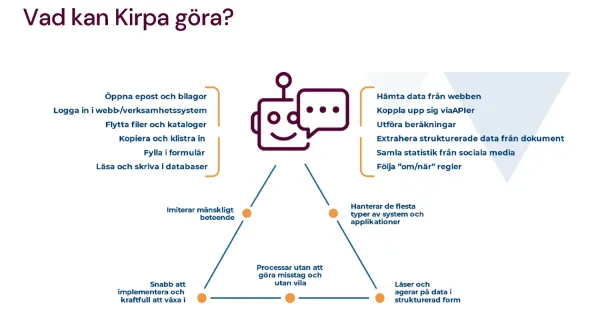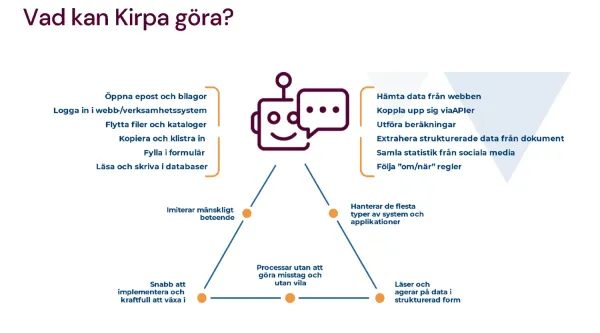The RPA team - for the automation of work tasks
KI is investing in automating selected administrative processes in areas such as finance and HR. This will lead to more efficient and safer working methods and free up time for more qualified tasks for employees. The role of the RPA team is to facilitate the continued implementation and, together with the rest of our organisation, identify candidate processes to continue working on.

RPA - robotic process automation
The technical term for this administration and business planning development is robotic process automation (RPA). It means that a software program (robot) is given instructions to perform tasks and processes previously carried out manually.
This should lead to:
- Resources are freed up by robotizing manual and repetitive digital processes. Employees concerned will have a reduced or simplified workload and can devote themselves to more skilled tasks.
- Reduced risk of manual errors and lower vulnerability.
- Increased possibilities to perform controls in a standardized way.
- Reduced burden on support systems as demanding runs can be done outside regular working hours.
RPA and AI - are they the same thing?
The picture below describes the differences in a simple way:
- RPA follows strict, pre-programmed rules and has no ability to learn or adapt beyond these rules.
- AI is the ability of a machine to mimic human thinking. AI involves machine learning and deep learning, allowing systems to learn from data, draw conclusions and make more complex decisions based on new information.
A robot simply does what it is programmed to do. KI's first robot is called Kirpa, and it can be programmed to, among other things:
- open emails and attachments
- log in to the web/business system
- move files and directories
- copy and paste
- filling in forms
- reading and writing databases
- retrieve data from the web
- connect via APIs
- perform calculations
- extract structured data from documents
- collect statistics from social media
- follow 'if/when' rules.
A first selection of processes
A number of processes have already been identified and are the first to be robotised. These are handling stuck invoices, automatic updating of currency codes, and holiday payroll, all of which are performed in KI's financial system UBW.
Please send us your suggestions!
The RPA Team would like you to submit suitable proposals for candidate processes! Your proposal must be agreed upon and anchored with your nearest unit manager. Read more under "Do you have suggestions for processes to automate?"
Supplier invoices that get stuck in the system are due, among other things, to missing recipients - for example, when a supplier invoice has arrived at KI that does not have a correct recipient (ZZ code).
Today, this requires manual handling to be moved into the UBW flow, which involves an investigation and manual connection to the correct recipient (ZZ code).
What are the benefits of automating the process?
A robot makes the process less labour-intensive and manual, saving time. The task can also be carried out outside of regular working hours.
In an average month, around 3000 invoices get stuck at KI, requiring manual investigation and processing. Thanks to the robotisation of the process, we now save about 20% in labour hours over a month.
At each monthly statement, the liability that KI has to employees regarding payment of vacation pay when taking a holiday is recognised. Employees earn vacation days when we work, and we may use these continuously throughout the year.
What are the benefits of automating the process?
The current balance after each payroll run is currently booked in UBW manually, but from 2024, this will be done automatically. The robot reverses the previous month's balance and then posts the accurate balance for the current month.
Daily exchange rates for different currencies are read for each banking day. The exchange rates form the basis in UBW for all invoices received from suppliers and invoices sent out to customers in currencies other than SEK. Since KI, as a government agency, reports all financial activities in SEK, we need daily exchange rates to give a fair picture of our accounting.
What are the benefits of automating the process?
Previously, this task was performed manually for each banking day; now, the robot retrieves the rates from the Riksbank website and applies them UBW.
Four resources were previously needed to create a monthly report of current IT contracts for the current billing period. These resources were then required to open the report for publication to the departments, and manually send emails to those concerned that the reports were available.
What are the benefits of automating the process?
This is a minor time savings, but the major benefit is better control of all parts and shorter lead times. Having the robot do the work ensures that it is done precisely according to the routine and at the right time, reducing the dependency on specific individuals.
How to automate a process?
The RPA team's responsibility is to assess whether submitted process proposals (candidate processes) are suitable for robotisation based on several established criteria. Below is a visual process map, and briefly, it goes like this:
- The operations submits a proposal for a candidate process
A description of the candidate process is produced, showing its background, purpose, benefits, and how it works today. A procedure description must be attached. Templates are listed below under Documents, and a link to the form is provided.
- The affected management object reviews the proposal.
The object that manages the existing process calls a meeting to review the candidate process and ensure that any additions are made. The first example above concerns applications within the management object "Affärssystem," where UBW is managed.
Then, the benefits of robotisation are assessed — does it benefit only one department/support service office or several? The object decides whether it is worth proceeding with the process and then informs the operations.
- The RPA team reviews the proposal
This is done to determine whether the process is clear, well-established, and rule-based. If ambiguities persist, the relevant object is contacted, and additional information from the operations is collected.
The relevant object and operations are informed if the candidate process is not deemed suitable for robotisation.
- The RPA group is responsible for prioritising the candidate process
Based on established criteria, a prioritisation is made among ongoing processes (see document below) - the relevant management object and operations are informed of the prioritisation.
- Evaluation of the process
Operations, the object and the RPA team evaluate the process. The different steps of the approved process are documented by a screen recording, and a so-called Process Design Document is produced by the RPA group.
- Robotisation is carried out by developers
The RPA group leads the work required to create the robot, which is done by developers through the UI Path platform.
- The robotic process is commissioned and enters the management organisation
Once the process is developed and commissioned, it is owned by the object concerned, which handles error messages and is responsible for making ongoing checks so that the robot works according to plan.
Dokument
Do you have suggestions for processes to automate?
Do you regularly work on tasks that you think would be suitable to automate? Something that requires time and accuracy but is repetitive to perform?
Cost and resources
Each department or office bears the cost of robotising the proposed process. The estimated cost of automation is based on the submitted process/procedure description.
In order to implement an automation, it is necessary that the organisation concerned allocates time to be involved throughout the work, until an implementation has taken place in the regular administration.
Feel free to contact us if you have any questions!
Send us your suggestions!
The RPA Team would like you to submit suitable proposals for candidate processes. Your proposal must be agreed upon and anchored with your nearest unit manager.



